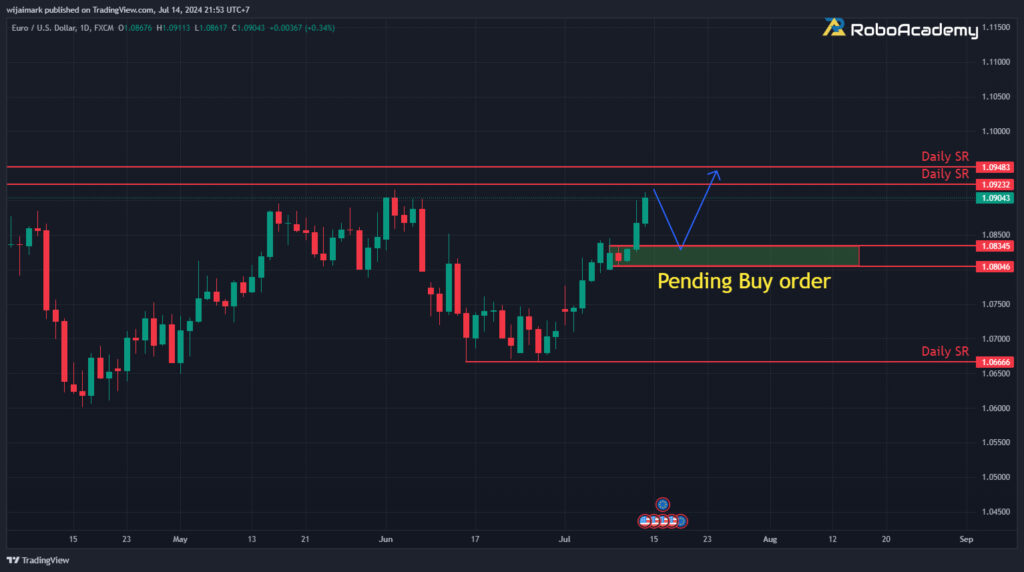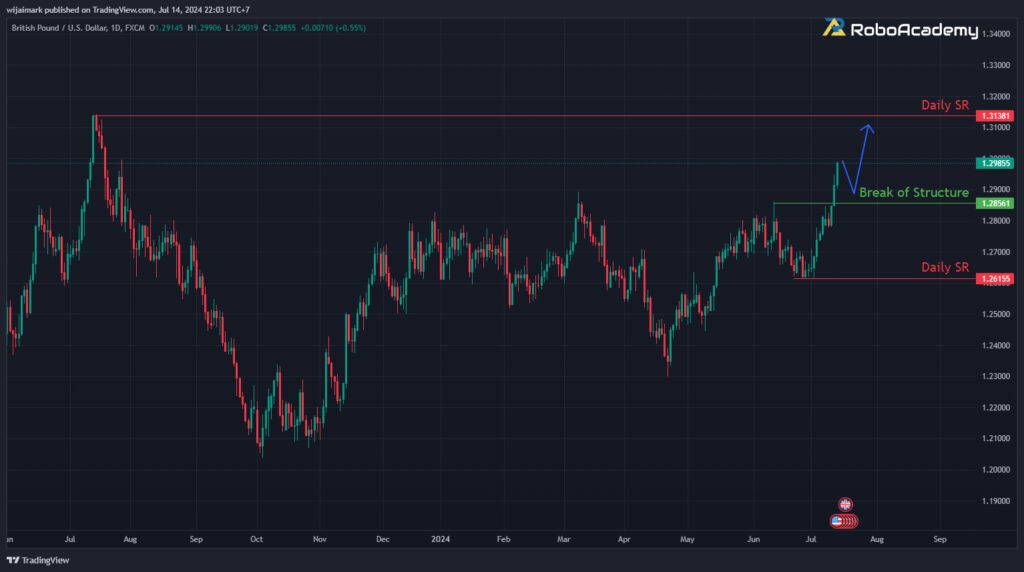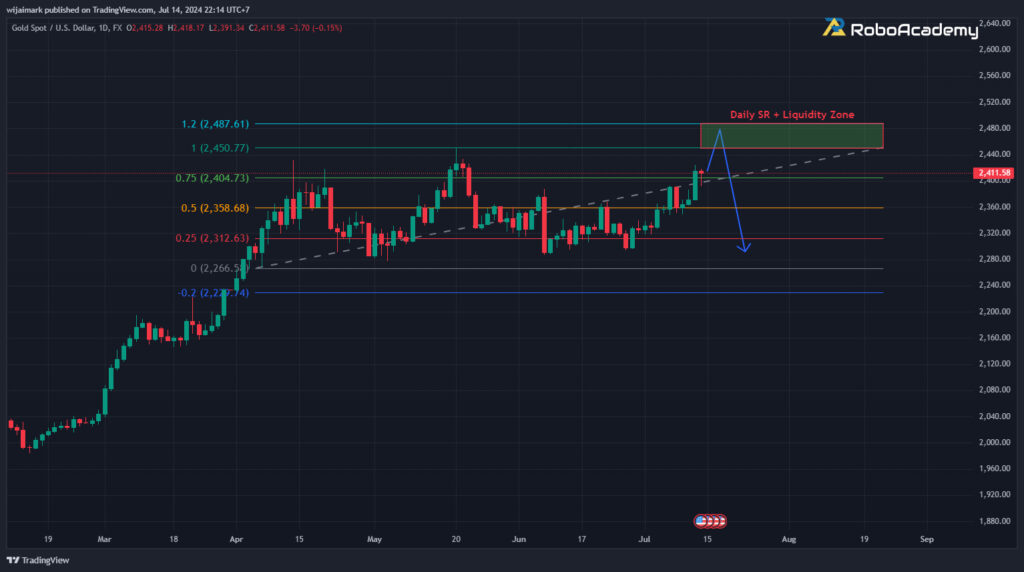Fundamental & Technical Analysis by Coach Mark RoboAcademy during 15 – 19 July 2024
Hello everyone, welcome to the weekly analysis of currency pairs EUR/USD, GBP/USD, and XAU/USD for the third week of July, from July 15-19, 2024.
EUR/USD, “Euro vs US Dollar”

Fundamental Analysis
Significant Economic Events Impacting EUR/USD This Week:
European Economic Data:
- Inflation Rate: The Harmonised Index of Consumer Prices (HICP) in the Eurozone is a key factor. The latest data indicating inflation trends can impact the EUR. Higher-than-expected inflation may lead the ECB to consider tighter monetary policy.
- GDP Growth: Eurostat’s GDP figures will affect the EUR. Strong growth trends can support the EUR.
- Unemployment Rate: Changes in the unemployment rate can indicate the economy’s health. Lower unemployment usually supports the currency.
- Industrial Production: Industrial production data can indicate the strength of the manufacturing sector.
U.S. Economic Data:
- CPI Data: The Consumer Price Index (CPI) of the United States is extremely important. Higher inflation rates may lead to expectations of more stringent interest rate hikes by the Federal Reserve.
- Retail Sales: Retail sales figures indicate the strength of consumer spending, which is a crucial component of the economy.
- Jobless Claims: Weekly unemployment claims can provide insights into the health of the labor market.
- Federal Reserve Statements: Speeches or statements from Federal Reserve officials are closely monitored for indications about future monetary policy.
Technical Analysis
The price has been adjusting strongly upwards. Currently, it is attempting to test the resistance zone around the price range of 1.09232-1.09483. If a sell price action occurs within this zone, you could consider entering to anticipate the price dropping to test the price zone around 1.08046-1.08345. This zone, if measured using Fibonacci tools, corresponds to the 0.618 Fibo level, making it an interesting zone to place an order. You should then wait for a buy price action to confirm entering an order.
GBP/USD, “Great Britain Pound vs US Dollar”

Fundamental Analysis
Significant Economic Events Impacting GBP/USD This Week:
U.K. Economic Data:
- Inflation Rate (CPI): The Consumer Price Index (CPI) of the UK is a crucial factor. Higher-than-expected inflation can impact the GBP by prompting the Bank of England (BoE) to consider raising interest rates.
- GDP Growth: GDP data affects the GBP, with strong growth supporting the currency.
- Unemployment Rate: Changes in the unemployment rate can indicate the economy’s health. Lower unemployment typically supports the currency.
- Retail Sales: Retail sales data can indicate strong consumer spending.
U.S. Economic Data:
- CPI Data: The Consumer Price Index (CPI) of the US is extremely important. Higher inflation may lead to expectations of more aggressive interest rate hikes by the Federal Reserve.
- Retail Sales: Retail sales figures indicate the strength of consumer spending, a critical component of the economy.
- Jobless Claims: Weekly unemployment claims provide insights into the health of the labor market.
- Federal Reserve Statements: Speeches or statements from Federal Reserve officials are closely monitored for indications about future monetary policy.
Technical Analysis
The current price has risen strongly after breaking the structure at 1.28561, now heading to test the resistance zone around 1.31381. At this point, it is advisable to wait for a correction in the smaller time frame to find a suitable buy entry point. Alternatively, if you can wait, it is recommended to look for a strong price pullback to retest the zone where the BOS occurred (around 1.28561). Since the price is trending, avoid buying immediately at any price due to the risk of a sharp pullback, which could result in a risky trade. It is suggested to wait for a correction and retest, and if confirmed, proceed with a buy.
XAU/USD, “Gold vs US Dollar”

Fundamental Analysis
Significant Economic Events Impacting XAU/USD This Week:
U.S. Economic Data:
- CPI Data: The Consumer Price Index (CPI) of the US is extremely important. Higher inflation may lead to expectations of more aggressive interest rate hikes by the Federal Reserve, which could pressure gold prices.
- Retail Sales: Retail sales figures indicate the strength of consumer spending, a critical component of the economy. Strong retail sales may result in a stronger USD, putting pressure on gold prices.
- Jobless Claims: Weekly unemployment claims provide insights into the labor market’s health. Positive data can strengthen the USD.
- Federal Reserve Statements: Speeches or statements from Federal Reserve officials are closely monitored for indications about future monetary policy. Hawkish announcements may lead to a stronger USD and put pressure on gold prices.
Global Economic Data:
- GDP Growth: GDP growth data from major global economies can influence the demand for gold. If the economy grows strongly, it may reduce the demand for gold as a safe-haven asset.
- Inflation Rates: Rising inflation rates globally can increase the demand for gold as an inflation hedge.
Technical Analysis
The current price is moving in a sideways-up trend, indicating it is within a range but attempting to rise. The strategy now might involve waiting to sell around the price zone of approximately 2450. As we know, gold tends to gather liquidity, so I am using the 20% rule for analysis. This means if the price swings beyond Fibo 1 but does not exceed Fibo 1.2, and then shows a rejection back down, closing below Fibo 1, it indicates that liquidity has been collected. This would be a signal to enter a sell position. Alternatively, you might consider using a “buy on dip” strategy for short-term gains while waiting to enter a sell on a high-probability setup in the upper zone of 2450-2490.
Be cautious, as there may be significant price movement due to recent news about the US presidential election—specifically, Mr. Donald Trump being shot while campaigning. This news could impact gold prices.
Disclaimer: This article is solely an analysis from the coach at RoboAcademy and is not intended as investment advice in any way. Investing is risky. Investors should study the information before making investment decisions.


